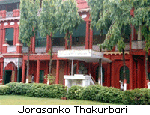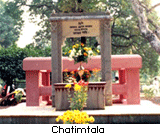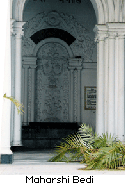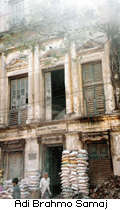 |
 Early life Early life
Debendranath was the eldest son of Prince Dwarkanath Tagore, who was often referred to as the "Indian Croesus" and was born in Jorasanko, in Calcutta, West Bengal.
Being the son of a Prince he was brought up in a lap of luxury surrounded by pomp and power. Yet providence led Debendranath to turn his back upon all pleasures and follies of youth at an early age. The silent observation of the stars one night on the bank of Ganges beside his grandmother's death bed filled his mind with wonder and the thought dawned on him that the grand universe that he saw before him could not have proceeded from any finite being.  Thakurbari One day in a state of extreme misery, while pacing up and down he noticed a stray leaf of a book flying past him. It was written in Sanskrit and those that knew better told him it was a page from the Upanishads. Ram Chandra Vidyabasgish who explained the meaning of the sloka to him. It was the opening verse of the Ishaponishad which said "God is immanent in all things, in whatsoever lives and moves in the universe; enjoy therefore without being attached; covet not wealth belonging to the others." From that day his course of life was changed forever. Thakurbari One day in a state of extreme misery, while pacing up and down he noticed a stray leaf of a book flying past him. It was written in Sanskrit and those that knew better told him it was a page from the Upanishads. Ram Chandra Vidyabasgish who explained the meaning of the sloka to him. It was the opening verse of the Ishaponishad which said "God is immanent in all things, in whatsoever lives and moves in the universe; enjoy therefore without being attached; covet not wealth belonging to the others." From that day his course of life was changed forever.
Tattwabodhini Sabha
Along with the awakening of the soul and the influence of Raja Rammohun Roy began asserting himself. In October 1839, he along with his friends started the Tattwaranjini Sabha which was later renamed to Tattwabodhini Sabha. Its object was the dissemination of the knowledge of the Upanishads and promotion of religious enquiry. In two years there were 500 members and also attracted rich and influential men of Bengal. Pt. Ishwar Chandra Vidyasagar was for sometime the secretary of this Sabha. It was the largest and most influential cultural organisation of Bengal and it lasted till 1854. It also had a printing press and Debendranath started publishing the Tattwabodhini Patrika. This Patrika became the principal organ of the Samaj for propagating its views. It taught men to think seriously and speak earnestly. It inaugurated the era of earnest journalism in Bengal. It was published in five different languages from five different centres - in Bengali from Calcutta, in Tamil and English from Madras and in Hindi and Urdu from Bareilly. and also attracted rich and influential men of Bengal. Pt. Ishwar Chandra Vidyasagar was for sometime the secretary of this Sabha. It was the largest and most influential cultural organisation of Bengal and it lasted till 1854. It also had a printing press and Debendranath started publishing the Tattwabodhini Patrika. This Patrika became the principal organ of the Samaj for propagating its views. It taught men to think seriously and speak earnestly. It inaugurated the era of earnest journalism in Bengal. It was published in five different languages from five different centres - in Bengali from Calcutta, in Tamil and English from Madras and in Hindi and Urdu from Bareilly.
Public Initiation into Brahmoism
 Debendranath framed a covenant for the adoption of the Church and to introduce a regular form of Church service, including thanks giving, praise and prayer. Having framed this covenant 20 of his young associates joined him on December 21, 1843 (7th Paush, 1765 B.E.). This led the step for converting Brahmo Samaj into a spiritual fraternity. This day is still commemorated by holding the annual Poush Mela at Shantiniketan. The history of the place goes back to the 1860s, when Debendranath was stuck by the beauty of the place. Debendranath framed a covenant for the adoption of the Church and to introduce a regular form of Church service, including thanks giving, praise and prayer. Having framed this covenant 20 of his young associates joined him on December 21, 1843 (7th Paush, 1765 B.E.). This led the step for converting Brahmo Samaj into a spiritual fraternity. This day is still commemorated by holding the annual Poush Mela at Shantiniketan. The history of the place goes back to the 1860s, when Debendranath was stuck by the beauty of the place. The westernmost corner of Bengal, Birbhum is a red laterite soil zone, watered by the several rain-fed rivulets. Passing through the village commons of Bhuvandanga (an area once avoided by travellers because of dacoits), Maharshi was captivated by the kaleidoscopic beauty of two luxuriantly canopied Chhatim trees, offering shade in that barren, red land. To the Maharshi, this was an idyllic venue for meditating. So he bought a large tract of land along with the two Chhatim trees and built a beautiful prayer hall made from coloured glass. Trees were planted all around to bring the ancient forest-ashram look. In keeping with the spirit of the place, Maharshi named it ‘Shantiniketan’ or the ‘abode of peace’. The westernmost corner of Bengal, Birbhum is a red laterite soil zone, watered by the several rain-fed rivulets. Passing through the village commons of Bhuvandanga (an area once avoided by travellers because of dacoits), Maharshi was captivated by the kaleidoscopic beauty of two luxuriantly canopied Chhatim trees, offering shade in that barren, red land. To the Maharshi, this was an idyllic venue for meditating. So he bought a large tract of land along with the two Chhatim trees and built a beautiful prayer hall made from coloured glass. Trees were planted all around to bring the ancient forest-ashram look. In keeping with the spirit of the place, Maharshi named it ‘Shantiniketan’ or the ‘abode of peace’.
Brahmo Dharma and its propagation
In the year 1845 there was controversy with the Christians regarding the conversion of Umesh Chandra Sarkar and his wife.  Debendranath used the Patrika to condemn such practices and the Christians attacked the Brahmo theology claiming it to be solely dependant on the Vedas. This led to Debendranath questioning the Debendranath used the Patrika to condemn such practices and the Christians attacked the Brahmo theology claiming it to be solely dependant on the Vedas. This led to Debendranath questioning the  Vedic infallibility and he wanted to keep the religion on the old lines of the Hindu scriptures. Accordingly he made a compilation of the selected passages from the Upanishads inculcating the Truths of monotheism. This was published in the form of a book called the Brahmo Dharma or the Religion of the Worshipper so the One True God. He also laid down certain fundamental principles of Natural Theism for acceptance of the members of the Samaj. The anniversary festival was held in 1850 with new music, new covenant and new prayers, and a marble pulpit was added to the Samaj - this was the Vedic infallibility and he wanted to keep the religion on the old lines of the Hindu scriptures. Accordingly he made a compilation of the selected passages from the Upanishads inculcating the Truths of monotheism. This was published in the form of a book called the Brahmo Dharma or the Religion of the Worshipper so the One True God. He also laid down certain fundamental principles of Natural Theism for acceptance of the members of the Samaj. The anniversary festival was held in 1850 with new music, new covenant and new prayers, and a marble pulpit was added to the Samaj - this was the  Adi Brahmo Samaj, though its present state is in ruins. Adi Brahmo Samaj, though its present state is in ruins.
The Patrika wrote articles supporting female education, widow re-marriage, crying against intemperance, denouncing polygamy, rationalise Brahmo doctrines and run the church on constitutional principles. A noteworthy feature of this period was the establishment of various Samajes in and around Calcutta. During this time Akshay Kumar Datta started a Friends Society - the younger members ventilated their feelings on the need for reforms and finally withdrew themselves from the Samaj only to forma separate samaj of their own. This was soon followed by the great schism in 1866 when the Navavidhan Brahmo Samaj or the Brahmo Samaj of India was born. Debendranath kept himself aloof and retired to hills of Simla in 1856 and occupied himself with prayer and meditation and studied closely the works Kant, Fichte, Victor Cousin etc. as well as writings of Hindu theologians and the Persian poet Hafiz. As a result of his studies he concluded that the broad universal basis of natural theism was that it was religion that explains the scriptures and not the scriptures religion.
Debendranath was essentially a Hindu in all his spiritual aims and aspirations. For his ideals of religion he never turned to the West. In matters of spiritual life he never made any visible approach, even of sympathising friendship towards Christ and his church. The Jewish and Christian concept of heaven and salvation seemed to him so anthropo-morphic that he passed them off with silent contempt and turned to the Hindu conception of God as immanent in matter and mind. In his work with the Brahmo Samaj he had two princples - 1) the Brahmo Samaj is a purely Hindu institution intended for Hindus and deals with the highest form of Hinduism and 2) its mission is chiefly religious rather than social. He was one of the first men in Bengal to open the doors of high education to women and indeed in his own family.
|
| |
|